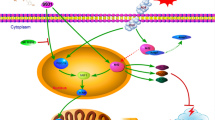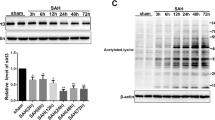Abstract
Oxidative stress is a key component of the pathological cascade in subarachnoid hemorrhage (SAH). Fucoxanthin (Fx) possesses a strong antioxidant property and has shown neuroprotective effects in acute brain injuries such as ischemic stroke and traumatic brain injury. Here, we investigated the beneficial effects of Fx against SAH-induced oxidative insults and the possible molecular mechanisms. Our data showed that Fx could significantly inhibit SAH-induced reactive oxygen species production and lipid peroxidation, and restore the impairment of endogenous antioxidant enzymes activities. In addition, Fx supplementation improved mitochondrial morphology, ameliorated neural apoptosis, and reduced brain edema after SAH. Moreover, Fx administration exerted an improvement in short-term and long-term neurobehavior functions after SAH. Mechanistically, Fx inhibited oxidative damage and brain injury after SAH by deacetylation of forkhead transcription factors of the O class and p53 via sirtuin 1 (Sirt1) activation. EX527, a selective Sirt1 inhibitor, significantly abated Fx-induced Sirt1 activation and abrogated the antioxidant and neuroprotective effects of Fx after SAH. In primary neurons, Fx similarly suppressed oxidative insults and improved cell viability. These effects were associated with Sirt1 activation and were reversed by EX527 treatment. Taken together, our study explored that Fx provided protection against SAH-induced oxidative insults by inducing Sirt1 signaling, indicating that Fx might serve as a potential therapeutic drug for SAH.







Similar content being viewed by others
Data Availability
The datasets generated and analyzed during this study are available from the corresponding author on reasonable request.
Abbreviations
- 8-OHdG:
-
8-Hydroxyguanosine
- CAT:
-
Catalase
- DCFH:
-
Dichlorodihydrofluorescein diacetate
- DMSO:
-
Dimethylsulfoxide
- EBI:
-
Early brain injury
- Fx:
-
Fucoxanthin
- GSH:
-
Glutathione
- GSH-Px:
-
Glutathione peroxidase
- HRP:
-
Horseradish peroxidase
- LDH:
-
Lactate dehydrogenase
- MDA:
-
Malondialdehyde
- MWM:
-
Morris water maze test
- OxyHb:
-
Oxyhemoglobin
- ROS:
-
Reactive oxygen species
- SOD:
-
Superoxide dismutase
- SAH:
-
Subarachnoid hemorrhage
- TUNEL:
-
Terminal deoxynucleotidyl transferase-mediated dUTP nick-end labeling
References
Zhang T, Wu P, Budbazar E, Zhu Q, Sun C, Mo J, Peng J, Gospodarev V et al (2019) Mitophagy reduces oxidative stress via Keap1 (Kelch-like epichlorohydrin-associated protein 1)/Nrf2 (nuclear factor-E2-related factor 2)/PHB2 (prohibitin 2) pathway after subarachnoid hemorrhage in rats. Stroke 50(4):978–988. https://doi.org/10.1161/STROKEAHA.118.021590
Zhang X, Wu Q, Lu Y, Wan J, Dai H, Zhou X, Lv S, Chen X et al (2018) Cerebroprotection by salvianolic acid B after experimental subarachnoid hemorrhage occurs via Nrf2- and SIRT1-dependent pathways. Free Radic Biol Med 124:504–516. https://doi.org/10.1016/j.freeradbiomed.2018.06.035
Chen S, Feng H, Sherchan P, Klebe D, Zhao G, Sun X, Zhang J, Tang J et al (2014) Controversies and evolving new mechanisms in subarachnoid hemorrhage. Prog Neurobiol 115:64–91. https://doi.org/10.1016/j.pneurobio.2013.09.002
Tao T, Liu GJ, Shi X, Zhou Y, Lu Y, Gao YY, Zhang XS, Wang H et al (2019) DHEA attenuates microglial activation via induction of JMJD3 in experimental subarachnoid haemorrhage. J Neuroinflammation 16(1):243. https://doi.org/10.1186/s12974-019-1641-y
Zuo G, Zhang T, Huang L, Araujo C, Peng J, Travis Z, Okada T, Ocak U et al (2019) Activation of TGR5 with INT-777 attenuates oxidative stress and neuronal apoptosis via cAMP/PKCepsilon/ALDH2 pathway after subarachnoid hemorrhage in rats. Free Radic Biol Med 143:441–453. https://doi.org/10.1016/j.freeradbiomed.2019.09.002
Terasaki M, Ikuta M, Kojima H, Tanaka T, Maeda H, Miyashita K, Mutoh M (2019) Dietary fucoxanthin induces anoikis in colorectal adenocarcinoma by suppressing integrin signaling in a murine colorectal cancer model. J Clin Med 9(1). https://doi.org/10.3390/jcm9010090
Zheng J, Tian X, Zhang W, Zheng P, Huang F, Ding G, Yang Z (2019) Protective effects of fucoxanthin against alcoholic liver injury by activation of Nrf2-mediated antioxidant defense and inhibition of TLR4-mediated inflammation. Mar Drugs 17(10). https://doi.org/10.3390/md17100552
Yang G, Jin L, Zheng D, Tang X, Yang J, Fan L, Xie X (2019) Fucoxanthin alleviates oxidative stress through Akt/Sirt1/FoxO3alpha signaling to inhibit HG-induced renal fibrosis in GMCs. Mar Drugs 17 (12). doi:https://doi.org/10.3390/md17120702
Ou HC, Chou WC, Chu PM, Hsieh PL, Hung CH, Tsai KL (2019) Fucoxanthin protects against oxLDL-induced endothelial damage via activating the AMPK-Akt-CREB-PGC1alpha pathway. Mol Nutr Food Res 63(10):e1801353. https://doi.org/10.1002/mnfr.201801353
Hu L, Chen W, Tian F, Yuan C, Wang H, Yue H (2018) Neuroprotective role of fucoxanthin against cerebral ischemic/reperfusion injury through activation of Nrf2/HO-1 signaling. Biomed Pharmacother 106:1484–1489. https://doi.org/10.1016/j.biopha.2018.07.088
McGrath JC, Lilley E (2015) Implementing guidelines on reporting research using animals (ARRIVE etc.): New requirements for publication in BJP. Br J Pharmacol 172(13):3189–3193. https://doi.org/10.1111/bph.12955
Tsai YR, Chang CF, Lai JH, Wu JC, Chen YH, Kang SJ, Hoffer BJ, Tweedie D et al (2018) Pomalidomide ameliorates H(2)O(2)-induced oxidative stress injury and cell death in rat primary cortical neuronal cultures by inducing anti-oxidative and anti-apoptosis effects. Int J Mol Sci 19(10). https://doi.org/10.3390/ijms19103252
Zhang L, Wang H, Fan Y, Gao Y, Li X, Hu Z, Ding K, Wang Y et al (2017) Fucoxanthin provides neuroprotection in models of traumatic brain injury via the Nrf2-ARE and Nrf2-autophagy pathways. Sci Rep 7:46763. https://doi.org/10.1038/srep46763
Yu L-M, Dong X, Xue X-D, Zhang J, Li Z, Wu H-J, Yang Z-L, Yang Y et al (2019) Protection of the myocardium against ischemia/reperfusion injury by punicalagin through an SIRT1-NRF-2-HO-1-dependent mechanism. Chem Biol Interact 306:152–162. https://doi.org/10.1016/j.cbi.2019.05.003
Lu Y, Zhang XS, Zhou XM, Gao YY, Chen CL, Liu JP, Ye ZN, Zhang ZH et al (2019) Peroxiredoxin 1/2 protects brain against H2O2-induced apoptosis after subarachnoid hemorrhage. FASEB J 33(2):3051–3062. https://doi.org/10.1096/fj.201801150R
Zhang X, Lu Y, Wu Q, Dai H, Li W, Lv S, Zhou X, Zhang X et al (2019) Astaxanthin mitigates subarachnoid hemorrhage injury primarily by increasing sirtuin 1 and inhibiting the Toll-like receptor 4 signaling pathway. FASEB J 33(1):722–737. https://doi.org/10.1096/fj.201800642RR
Zhang D, Zhang H, Hao S, Yan H, Zhang Z, Hu Y, Zhuang Z, Li W et al (2016) Akt specific activator SC79 protects against early brain injury following subarachnoid hemorrhage. ACS Chem Neurosci 7(6):710–718. https://doi.org/10.1021/acschemneuro.5b00306
Zhang XS, Li W, Wu Q, Wu LY, Ye ZN, Liu JP, Zhuang Z, Zhou ML et al (2016) Resveratrol attenuates acute inflammatory injury in experimental subarachnoid hemorrhage in rats via inhibition of TLR4 pathway. Int J Mol Sci 17(8):e1131. https://doi.org/10.3390/ijms17081331
Han X, Lan X, Li Q, Gao Y, Zhu W, Cheng T, Maruyama T, Wang J (2016) Inhibition of prostaglandin E2 receptor EP3 mitigates thrombin-induced brain injury. J Cereb Blood Flow Metab 36(6):1059–1074. https://doi.org/10.1177/0271678X15606462
Sugawara T, Ayer R, Jadhav V, Zhang JH (2008) A new grading system evaluating bleeding scale in filament perforation subarachnoid hemorrhage rat model. J Neurosci Methods 167(2):327–334. https://doi.org/10.1016/j.jneumeth.2007.08.004
Liu H, Guo W, Guo H, Zhao L, Yue L, Li X, Feng D, Luo J et al (2020) Bakuchiol attenuates oxidative stress and neuron damage by regulating Trx1/TXNIP and the phosphorylation of AMPK after subarachnoid hemorrhage in mice. Front Pharmacol 11:712. https://doi.org/10.3389/fphar.2020.00712
Zhang XS, Wu Q, Wu LY, Ye ZN, Jiang TW, Li W, Zhuang Z, Zhou ML et al (2016) Sirtuin 1 activation protects against early brain injury after experimental subarachnoid hemorrhage in rats. Cell Death Dis 7(10):e2416. https://doi.org/10.1038/cddis.2016.292
Kong ZL, Sudirman S, Hsu YC, Su CY, Kuo HP (2019) Fucoxanthin-rich brown algae extract improves male reproductive function on streptozotocin-nicotinamide-induced diabetic rat model. Int J Mol Sci 20(18). https://doi.org/10.3390/ijms20184485
Alghazwi M, Smid S, Musgrave I, Zhang W (2019) In vitro studies of the neuroprotective activities of astaxanthin and fucoxanthin against amyloid beta (Abeta1-42) toxicity and aggregation. Neurochem Int 124:215–224. https://doi.org/10.1016/j.neuint.2019.01.010
Chen J, Wang L, Wu C, Hu Q, Gu C, Yan F, Li J, Yan W et al (2014) Melatonin-enhanced autophagy protects against neural apoptosis via a mitochondrial pathway in early brain injury following a subarachnoid hemorrhage. J Pineal Res 56(1):12–19. https://doi.org/10.1111/jpi.12086
Zhao L, Liu H, Yue L, Zhang J, Li X, Wang B, Lin Y, Qu Y (2016) Melatonin attenuates early brain injury via the melatonin receptor/Sirt1/NF-kappaB signaling pathway following subarachnoid hemorrhage in mice. Mol Neurobiol 54(3):1612–1621. https://doi.org/10.1007/s12035-016-9776-7
Zhao L, An R, Yang Y, Yang X, Liu H, Yue L, Li X, Lin Y et al (2015) Melatonin alleviates brain injury in mice subjected to cecal ligation and puncture via attenuating inflammation, apoptosis, and oxidative stress: The role of SIRT1 signaling. J Pineal Res 59(2):230–239. https://doi.org/10.1111/jpi.12254
Ji L, Wang Q, Huang F, An T, Guo F, Zhao Y, Liu Y, He Y et al (2019) FOXO1 overexpression attenuates tubulointerstitial fibrosis and apoptosis in diabetic kidneys by ameliorating oxidative injury via TXNIP-TRX. Oxidative Med Cell Longev 2019:3286928–3286914. https://doi.org/10.1155/2019/3286928
Zhang Y, Sun C, Xiao G, Shan H, Tang L, Yi Y, Yu W, Gu Y (2019) S-nitrosylation of the Peroxiredoxin-2 promotes S-nitrosoglutathione-mediated lung cancer cells apoptosis via AMPK-SIRT1 pathway. Cell Death Dis 10(5):329. https://doi.org/10.1038/s41419-019-1561-x
Zhang F, Wang S, Gan L, Vosler PS, Gao Y, Zigmond MJ, Chen J (2011) Protective effects and mechanisms of sirtuins in the nervous system. Prog Neurobiol 95(3):373–395. https://doi.org/10.1016/j.pneurobio.2011.09.001
Hernandez-Jimenez M, Hurtado O, Cuartero MI, Ballesteros I, Moraga A, Pradillo JM, McBurney MW, Lizasoain I et al (2013) Silent information regulator 1 protects the brain against cerebral ischemic damage. Stroke 44(8):2333–2337. https://doi.org/10.1161/STROKEAHA.113.001715
Chang YH, Chen YL, Huang WC, Liou CJ (2018) Fucoxanthin attenuates fatty acid-induced lipid accumulation in FL83B hepatocytes through regulated Sirt1/AMPK signaling pathway. Biochem Biophys Res Commun 495(1):197–203. https://doi.org/10.1016/j.bbrc.2017.11.022
Jin Q, Yan T, Ge X, Sun C, Shi X, Zhai Q (2007) Cytoplasm-localized SIRT1 enhances apoptosis. J Cell Physiol 213(1):88–97. https://doi.org/10.1002/jcp.21091
Chen X, Pan Z, Fang Z, Lin W, Wu S, Yang F, Li Y, Fu H et al (2018) Omega-3 polyunsaturated fatty acid attenuates traumatic brain injury-induced neuronal apoptosis by inducing autophagy through the upregulation of SIRT1-mediated deacetylation of Beclin-1. J Neuroinflammation 15(1):310. https://doi.org/10.1186/s12974-018-1345-8
Funding
This work was supported by grants from the National Natural Science Foundation of China (NSFC) (No. 81870922 for W.L., NO.81771291 for C.-H.H., No. 81971127 for Z.Z., 81901203 for Y.L.), Key Project supported by Medical Science and technology development Foundation, Nanjing Department of Health (No. JQX18001 for W.L.), Fundamental Research Funds for the Central Universities (No. 021414380361 for W. L.), Natural Science Research Project in Higher Education of Anhui Province (No. KJ2018A0253 for D.-Y.X.), and the Science Research Project of Professional personnel of the First Affiliated Hospital of Wannan Medical College (No. YR201911).
Author information
Authors and Affiliations
Contributions
XSZ performed the studies and wrote the manuscript. HW and XZL participated in creating the experimental animal model. HW, DYX, and GJL contributed to the Western blotting and the immunofluorescence staining. TT, YL, and XSZ performed the in vitro studies. WL, CL, and HCH contributed to the design and analysis of the study and revised the manuscript. All authors analyzed the results and approved the final version of the manuscript.
Corresponding author
Ethics declarations
Conflict of Interest
The authors declare that they have no conflict of interest.
Additional information
Publisher’s Note
Springer Nature remains neutral with regard to jurisdictional claims in published maps and institutional affiliations.
Electronic Supplementary Material
ESM 1
The purity of primary neuron. The particle analysis was performed by ImageJ and the purity of primary neuron was more than 90%. (PNG 459 kb)
Rights and permissions
About this article
Cite this article
Zhang, XS., Lu, Y., Tao, T. et al. Fucoxanthin Mitigates Subarachnoid Hemorrhage-Induced Oxidative Damage via Sirtuin 1-Dependent Pathway. Mol Neurobiol 57, 5286–5298 (2020). https://doi.org/10.1007/s12035-020-02095-x
Received:
Accepted:
Published:
Issue Date:
DOI: https://doi.org/10.1007/s12035-020-02095-x




